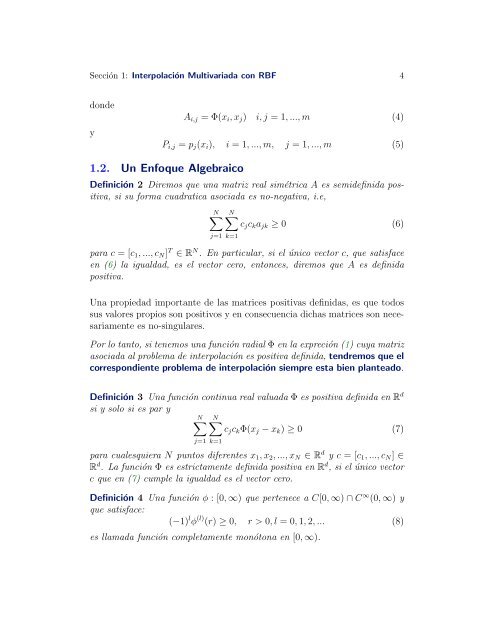Introducción a la teoría de Funciones Radiales - UNAM
Introducción a la teoría de Funciones Radiales - UNAM
Introducción a la teoría de Funciones Radiales - UNAM
You also want an ePaper? Increase the reach of your titles
YUMPU automatically turns print PDFs into web optimized ePapers that Google loves.
Sección 1: Interpo<strong>la</strong>ción Multivariada con RBF 4<br />
don<strong>de</strong><br />
y<br />
Ai,j = Φ(xi, xj) i, j = 1, ..., m (4)<br />
Pi,j = pj(xi), i = 1, ..., m, j = 1, ..., m (5)<br />
1.2. Un Enfoque Algebraico<br />
Definición 2 Diremos que una matriz real simétrica A es semi<strong>de</strong>finida positiva,<br />
si su forma cuadratica asociada es no-negativa, i.e,<br />
N<br />
j=1 k=1<br />
N<br />
cjckajk ≥ 0 (6)<br />
para c = [c1, ..., cN] T ∈ R N . En particu<strong>la</strong>r, si el único vector c, que satisface<br />
en (6) <strong>la</strong> igualdad, es el vector cero, entonces, diremos que A es <strong>de</strong>finida<br />
positiva.<br />
Una propiedad importante <strong>de</strong> <strong>la</strong>s matrices positivas <strong>de</strong>finidas, es que todos<br />
sus valores propios son positivos y en consecuencia dichas matrices son necesariamente<br />
es no-singu<strong>la</strong>res.<br />
Por lo tanto, si tenemos una función radial Φ en <strong>la</strong> expreción (1) cuya matriz<br />
asociada al problema <strong>de</strong> interpo<strong>la</strong>ción es positiva <strong>de</strong>finida, tendremos que el<br />
correspondiente problema <strong>de</strong> interpo<strong>la</strong>ción siempre esta bien p<strong>la</strong>nteado.<br />
Definición 3 Una función continua real valuada Φ es positiva <strong>de</strong>finida en Rd si y solo si es par y<br />
N N<br />
cjckΦ(xj − xk) ≥ 0 (7)<br />
j=1 k=1<br />
para cualesquiera N puntos diferentes x1, x2, ..., xN ∈ R d y c = [c1, ..., cN] ∈<br />
R d . La función Φ es estrictamente <strong>de</strong>finida positiva en R d , si el único vector<br />
c que en (7) cumple <strong>la</strong> igualdad es el vector cero.<br />
Definición 4 Una función φ : [0, ∞) que pertenece a C[0, ∞) ∩ C ∞ (0, ∞) y<br />
que satisface:<br />
(−1) l φ (l) (r) ≥ 0, r > 0, l = 0, 1, 2, ... (8)<br />
es l<strong>la</strong>mada función completamente monótona en [0, ∞).


